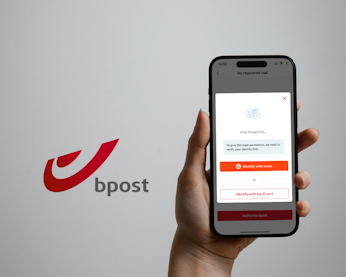
Digital identity’s role in shaping the future of postal services
Europe’s postal providers are navigating shrinking margins and rising competition. Mail volumes are in long-term decline, parcel margins are razor-thin, and competition is intensifying—not just from private couriers, but also from e-commerce giants leveraging their own delivery infrastructure. For instance, Bol.com retail platform is launching its own delivery service in some parts of the Netherlands. Amazon has introduced Amazon Shipping service in the UK, allowing third-party retailers to utilise its delivery network for their own shipments.
Nevertheless, postal operators have two major assets to leverage: trust and reach. They are among the few institutions with a recognised public role that is embedded within society, and a physical presence that permeates nearly every geographical corner. These strengths become even more valuable when paired with verified digital identity, which is helping many postal providers to modernise their postal platforms and provide their customers with seamless, remote experiences.
Digital identity platforms enable postal services to digitise operations while strengthening trust and reducing the risk of postal fraud. Key features such as secure identity verification, post address verification, passwordless authentication, and verified confirmations help streamline services, improve the postal customer login process, and reduce friction in the overall customer experience.
Platforms like itsme® go even a step further, offering qualified trust services like data sharing, single-attribute qualification, and qualified electronic signatures. These capabilities allow postal providers to expand into new sectors, unlock e-commerce partnerships, and fight scams like Buy Now, Pay Later (BNPL) fraud without the burden of building and maintaining their own identity infrastructure.
This blog explores how digital identity platforms can help Europe’s postal providers extend their relevance, drive secure innovation, and claim a new role in the digital economy.
1. Securing postal players against fraud and delivery risk
Security through authentication:
With the growth of e-commerce and rising concerns over digital fraud, it is critical to ensure that packages—especially high-value or sensitive deliveries—have reached the correct recipients. Digital identity solutions enable postal providers to authenticate recipients at checkout or upon delivery, reducing the risk of postal fraud and BNPL scams. These tools also strengthen postal address validation processes to ensure that packages are delivered to the right person without the need for a physical ID check.
An example is Posti in Finland, which is piloting the SisuID digital identity system to improve how it verifies customers both online and at delivery points. The pilot aims to enhance service efficiency, strengthen security, and support Posti’s ongoing digital transformation.
In Germany, Deutsche Post (which is owned by DHL) leverages digital identity technology to ensure a secure, contactless verification for parcel collection in compliance with strict regulatory standards. Through the Deutsche Post & DHL App, users can authenticate their identity using secure methods, including video identification, electronic ID (eID) verification with German ID cards, and AutoID, where customers submit a selfie alongside a photo of their ID.
Security through confirmation:
Confirmation through verified digital identity solutions can help mitigate several of the most common and costly types of fraud. For instance, using a digital ID tool for app-based delivery confirmations can help prevent porch piracy by ensuring that parcels are received by the intended recipient. Similarly, confirming receipt through a digital identity platform combats "items not received" fraud by providing verifiable proof of delivery.
Preventing Buy Now, Pay Later fraud
BNPL fraud is an escalating risk for both retailers and postal operators, driven by weak identity verification standards. Fraudsters exploit BNPL platforms by creating accounts with stolen or fake identities, often using only basic information like a name, email, phone number, and date of birth, without government ID or biometric checks. They place orders under someone else’s name, sending both the parcel and the invoice to the victim’s address. Before the victim becomes aware, the fraudster reroutes or intercepts the parcel, ensuring they receive the goods before the invoice arrives.
Digital identity tools can help break this cycle by verifying a customer’s identity and address before dispatch. This allows postal providers to anchor deliveries to real, authenticated individuals, reducing the risk of rerouting scams and ensuring that only the correct recipient receives the parcel. This ultimately protects the integrity of the delivery chain without adding friction to the customer experience.
Curious about the possibilities of verified digital identity? Click here to learn more
2. Modernising and automating postal services
Many postal operators still need to shift away from legacy, paper-based operations. Physical identity checks, manual data entry, and in-person appointments still dominate key processes, slowing down service and increasing costs. McKinsey highlights that postal incumbents are grappling with structurally uncompetitive labour costs, which are 20 to 40 percent higher than those of emerging competitors. They also suffer from outdated IT systems and risk-averse cultures.
These challenges are eroding traditional advantages like strong branding and economies of scale, underscoring the urgent need for digital transformation in the postal sector. Here too, digital identity becomes crucial for modernising operations and launching secure digital services, by:
Enhancing operational efficiency: Digital identity solutions help automate routine in-branch services such as parcel pickups, change-of-address requests, post address verification, or identity verification. Customers can authenticate themselves in seconds using digital identity apps, whether at a service counter, kiosk, or remotely via a secure postal customer login. This automation reduces queues, lowers support volumes, and eases the manual workload on staff. For example, La Poste in France enables customers to verify their identity at service points using digital tools, speeding up interactions and improving overall service quality while reducing exposure to postal fraud.
Digitising current product offerings: Postal services are modernising their core offerings by integrating secure digital identity solutions into their postal platforms. For instance, bpost has partnered with digital identity platform itsme® to streamline the handling of registered mail, enabling users to authenticate their identity within the My bpost app to receive registered mail. Through validated itsme® identification, bpost clients can also assign a proxy to receive registered mail, reducing the risk of postal fraud.
Becoming more customer centric: Postal digital ID enables customers to access postal services online, eliminating the need for manual intervention or visits to post offices. For example, PostNL in Belgium uses itsme® to activate mandate to change delivery preferences through a secure postal customer login. This speeds up processes and empowers users to use the postal platforms to manage services at their convenience.
To accelerate their transformation, many postal operators outsource digital ID to specialised providers and standalone digital ID applications, which enable postal players to leverage proven solutions into their postal platforms without the need to develop and maintain their own infrastructure. The result is shorter implementation timelines and lower operational costs.
Learn more about itsme® , the leading digital ID provider in Europe
3. Elevating the e-commerce experience
Enhance delivery security: By integrating digital identity solutions, postal services and e-commerce platforms can allow customers to securely share verified delivery preferences and addresses at checkout. Additionally, authenticating customers' identities via mobile apps before delivering their packages helps postal services to prevent postal fraud, BNPL scams, and address manipulation. This boosts customer trust and satisfaction and demonstrates a strong commitment to security.
Build customer trust: Digital identity helps postal operators build a more secure, trusted, and privacy-respecting brand. With privacy and data protection becoming a central concern for consumers, becoming a champion of secure digital identity is a clear competitive advantage. For example, the UK’s Royal Mail has implemented the Post Office EasyID app as a digital identity solution that allows customers to verify their identity online to access trust services, such as tracked mail or parcel collection. The app can also serve as proof of identity for mail collection and national lottery ticket purchases at post offices, convenience stores and retailers across the UK.
Age-sensitive deliveries made simple: For regulated deliveries, such as alcohol, tobacco, or age-restricted products, digital identity provides an easy way to verify the recipient's age using postal platforms without the need for physical ID checks at the door. L’Identité Numérique La Post in France has adopted this model, enabling customers to use their digital ID to confirm their identity before receiving a delivery, which saves time and ensures that the correct individual is receiving the delivery. This technology is particularly useful for e-commerce merchants who must comply with strict age verification laws.
Read more: How can postal services grow their revenue in 2026?
4. Facilitating regulatory compliance
Postal operators typically diversify into other services, such as financial products or e-commerce. In these industries, there is a high need for digital identity due to strict regulations on security, data protection and identity verification (e.g. KYC/AML). In this case, digital identity platforms play a critical role in ensuring compliance while simplifying operations.
Digital ID supports sector-specific compliance. For instance, in the case of postal operators offering banking or insurance, eKYC regulations require robust identity proofing, often at a Level of Assurance (LoA) 'High'. Digital identity platforms for postal operators streamline this process, combining document checks with multi-factor authentication, while keeping a full audit trail to satisfy regulators while preventing BNPL scams.
Digital ID solutions also help postal services meet GDPR requirements by enabling privacy-by-design and clear, user-controlled consent flows. This reduces legal risk while fostering transparency and trust with customers. Verified digital identity also limits unnecessary data collection, aligning with the EU’s emphasis on data minimisation while reducing opportunities for postal fraud.
By embedding certified, high-assurance digital identity solutions, postal providers future-proof their operations against evolving regulatory demands across the EU.
Curious about the potential use cases of digital identity in your team?
5. Transparent and predictable pricing
Digital identity platforms with user-based pricing models offer postal operators a clearer path to digitisation. While transaction-based systems charge per interaction, making costs unpredictable as usage grows, user-based models, like the one adopted by itsme® , offer fixed, per-user pricing. This enables postal providers to plan budgets with confidence while scaling services across millions of users, including those using secure postal customer login features.
itsme® allows unlimited identity events per user, such as secure logins, digital signatures, or age verification checks, without extra charges per authentication or verification. This setup is ideal for high-volume services such as mail redirection, digital KYC for banking partners, secure pickup authorisations, or preventing BNPL fraud or other types of postal fraud.
User-based pricing models not only improve cost-efficiency, but also reduce internal friction when rolling out new services. This is because each new feature doesn’t add incremental ID verification costs. This makes it easier for postal providers to offer identity-based services across mobile apps, self-service lockers, or partner platforms without needing to renegotiate pricing or track usage limits.
Where can postal services start with digital identity adoption?
Postal providers looking to adopt digital identity don’t need to develop their own solutions from scratch. Mature platforms already exist to support core identity functions, such as digital verification, passwordless authentication, secure data sharing, and electronic signatures. One example is itsme® , an EU-based app currently available in 27 countries, offering a practical foundation for postal operators aiming to digitise securely and at scale.
itsme® has become a trusted standard for identity verification in highly regulated environments, including banking, government services, and e-commerce. Used by millions across Europe, it enables secure authentication for a wide range of services. In the postal context, itsme® has been integrated by companies like bpost and PostNL in Belgium to facilitate secure and user-friendly delivery processes.
Unlock the full potential of your operations with digital identity

